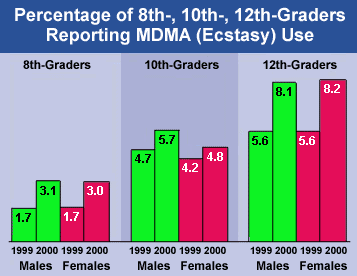Annual Survey Finds Increasing Teen Use of Ecstasy, Steroids
Download PDF Version What is PDF?
Patrick Zickler
Patrick Zickler is a Staff Writer for NIDA NOTES.
Source: NIDA NOTES, Vol. 16, No. 2, May, 2001
Public Domain
Table of Contents (TOC)
Article: Annual Survey Finds Increasing Teen Use Of Ecstasy, SteroidsFor the fourth year in a row, the percentages of 8th-, 10th-, and 12th-graders avoiding all use of illicit drugs remained level or increased in 2000, according to the 26th annual Monitoring the Future study. However, the nationwide survey of drug use among teenagers found that use of MDMA (ecstasy) has increased in all age groups and that use of steroids has risen among 10th-graders.
 The findings marked the second consecutive year of increased MDMA use
among 10th- and 12th-graders and the first increase among 8th-graders.
In 2000, 8.3 percent of 12th-graders reported that they had used MDMA
at least once in the past year, up from 5.6 percent in 1999 and 3.6
percent in 1998. Eighth-graders’ use of the drug increased from 1.7
percent in 1999 to 3.1 percent in 2000. Among 10th-graders, past-year
MDMA use remained statistically unchanged, at 5.4 percent in 2000, but
use in the past month increased from 1.8 percent in 1999 to 2.6 percent
last year, according to the study’s principal investigator, Dr. Lloyd
Johnston of the University of Michigan in Ann Arbor.
The findings marked the second consecutive year of increased MDMA use
among 10th- and 12th-graders and the first increase among 8th-graders.
In 2000, 8.3 percent of 12th-graders reported that they had used MDMA
at least once in the past year, up from 5.6 percent in 1999 and 3.6
percent in 1998. Eighth-graders’ use of the drug increased from 1.7
percent in 1999 to 3.1 percent in 2000. Among 10th-graders, past-year
MDMA use remained statistically unchanged, at 5.4 percent in 2000, but
use in the past month increased from 1.8 percent in 1999 to 2.6 percent
last year, according to the study’s principal investigator, Dr. Lloyd
Johnston of the University of Michigan in Ann Arbor.
Use of steroids during the year prior to the survey rose from 1.7 percent in 1999 to 2.2 percent in 2000 among 10th-graders but remained stable at 1.7 percent among 8th- and 12th-graders. Among teenage males, where most steroid use is concentrated, past-year use was reported by 2.2 percent of 8th-graders, 3.6 percent of 10th-graders, and 2.5 percent of 12th-graders, Dr. Johnston said at a December 2000 press conference announcing the most recent findings.
 Graph on Steroid Trends in High School Children
Graph on Steroid Trends in High School Children The Monitoring the Future study, conducted by the University of Michigan’s Institute for Social Research and funded by NIDA, has tracked high school seniors’ illicit drug use and attitudes toward drugs since 1975. Younger teens, in grades 8 and 10, were added to the survey in 1991. Data for the 2000 survey represent responses of more than 45,000 students in 435 schools across the Nation to questions about lifetime use, use during the past year, use during the past month, and daily use of various illicit drugs, alcohol, cigarettes, and smokeless tobacco.
"This survey provides crucial information on the real-world experience of young people with drugs, and the recent increases in MDMA use are a major concern," said NIDA Director Dr. Alan I. Leshner. "Ecstasy is not a ’fun’ drug. It is neurotoxic-it severely damages brain cells and has consequences that include dehydration, hypertension, hyperthermia, and heart or kidney failure."
 Graph on MDMA Trends in High School Children
Graph on MDMA Trends in High School Children The number of 8th-graders having used an illicit drug during the past year has declined steadily from 22.1 percent in 1997 to 19.5 percent in 2000. Among 10th-graders, use of an illicit drug was reported by 38.5 percent in 1997 and 36.4 percent in 2000. For seniors, past-year use of an illicit drug was reported by 42.4 percent in 1997 and by 40.9 percent in 2000.
Tenth-graders’ past-month use of cigarettes was 23.9 percent in 2000, roughly the same as in 1999; however, daily cigarette smoking decreased significantly in this group, from 15.9 percent to 14.0 percent. Daily smoking among 12th-graders declined from 23.1 percent in 1999 to 20.6 percent in 2000.
Reductions in other measures of smoking also occurred among 8th-, 10th-, and 12th-graders. "For cigarettes, and for smokeless tobacco as well, the overall declines from peak levels of the mid-90s have been substantial," Dr. Johnston says. Alcohol use by teens remained largely unchanged in 2000.


